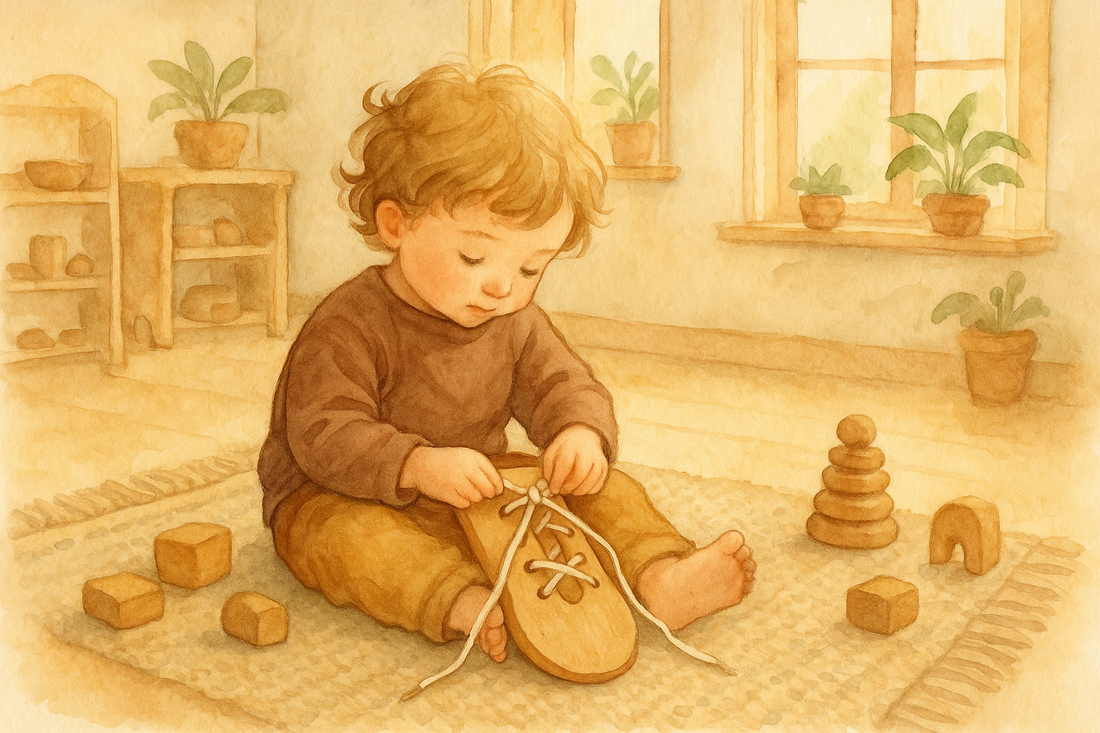
The Seven-Year Change and the Sacred Act of Shoe-Tying: A Waldorf Perspective on Readiness, Reverence, and Real Tools
Share
The Seven-Year Change and the Sacred Act of Shoe-Tying: A Waldorf Perspective on Readiness, Reverence, and Real Tools
Last autumn, during our Grade 1 parent evening, a mother raised her hand with tears in her eyes.
"My daughter is the only one in her class who can't tie her shoes. Should I be worried?"
Our class teacher, Mrs. Rose, smiled that knowing smile Waldorf teachers perfect over decades.
"Is she still losing teeth?"
The mother nodded.
"Then her hands are still becoming. Trust the wisdom of her development. When her body is ready, her hands will know."
Three months later, after her seventh birthday, that same child not only learned to tie her shoes but taught her younger brother using a song she composed herself.
This is the Waldorf way—waiting for the sacred moment when body, soul, and spirit align.
If you're a Waldorf parent wondering when and how to approach shoe-tying, if you're wrestling with well-meaning relatives who insist your 5-year-old is "behind," or if you're seeking a way to honor this milestone that aligns with Steiner's insights about child development...
This is for you.
The Sacred Geometry of Shoelaces: Why Waldorf Waits
In our modern world of velcro and slip-ons, shoe-tying might seem like an antiquated skill. But through Waldorf eyes, it's something far more profound.
It's the child's first conscious creation of the lemniscate—the infinity symbol.
Rudolf Steiner spoke extensively about the lemniscate as a fundamental form in human development. When a child ties their shoes, they're literally weaving infinity with their hands, creating a form that mirrors:
- The figure-eight of crawling patterns
- The infinity breath of eurythmy
- The crossing point between earthly and spiritual realms
But here's what Steiner understood that modern education misses:
This sacred geometry should only be attempted when the etheric body is ready.
The Seven-Year Rhythm
In Waldorf education, we recognize that the etheric body—the body of life forces and memory—isn't fully "born" until around age seven, marked by the changing of teeth.
Before this:
- The child's life forces are busy building the physical body
- Fine motor skills are still incarnating
- Forcing complex tasks diverts energy from essential growth
After the change of teeth:
- Life forces become available for learning
- Memory crystallizes
- The hands become true tools of the will
This is why Waldorf kindergartens don't teach shoe-tying. We're not being old-fashioned. We're being developmentally reverent.
The Hidden Curriculum in a Bow
When approached at the right time, shoe-tying becomes a complete Waldorf lesson:
Practical Life as Sacred Work
In Waldorf philosophy, all practical work is spiritual practice. When a child ties their shoes, they're:
- Bringing order to chaos (loops from straight laces)
- Creating beauty through function
- Participating in the human gift of transformation
The Development of Will
Steiner identified will development as crucial in the first seven years. Shoe-tying is pure will activity:
- Intention must be sustained through multiple steps
- Fingers must obey the mind's picture
- Completion requires pushing through frustration
Sensory Integration
The twelve senses Steiner described are all engaged:
- Touch (feeling the laces)
- Life (sensing tension and pressure)
- Movement (proprioception of hand positions)
- Balance (maintaining posture while tying)
The Social Gesture
In Waldorf communities, older children teaching younger ones is sacred tradition. Shoe-tying becomes a rite of passage—passed from child to child, not adult to child.
Why Traditional Methods Fail Waldorf Children
Most shoe-tying methods are designed for efficiency. But Waldorf children, who've been protected from early intellectualization, often struggle with conventional approaches:
The Bunny Ear Method: Requires abstract thinking ("imagine bunny ears"). Waldorf children under seven live in imagination but not abstraction.
YouTube Tutorials: Screen-based learning contradicts everything about embodied Waldorf education. The hands learn from hands, not pixels.
Competitive Learning: "Let's see who can tie fastest!" violates the Waldorf principle of non-competitive early childhood.
Adult Pressure: "You're five, you should know this" ignores individual developmental timing.
Our children need something different. Something that honors their unique developmental path.
The Waldorf Approach to Shoe-Tying
Here's how Waldorf teachers and parents can approach this milestone:
Grade 1: The Preparation Year
Finger games and string stories:
- Complex finger knitting
- Cat's cradle variations
- Weaving on simple looms
- Braiding bread dough
No direct shoe-tying instruction. Build the foundation through joyful, purposeful hand work.
Grade 2: The Introduction
Through story and verse:
Round about, round about, goes the hare
Through the hole, through the hole, everywhere
Pull it tight, pull it tight, good and true
Now you've made a gift for your shoe!
Make it seasonal:
- Autumn: "Binding the harvest sheaves"
- Winter: "Wrapping gifts for the gnomes"
- Spring: "The butterfly emerges from its cocoon"
Grade 3: Mastery Through Practical Work
By Grade 3 (age 8-9), children are studying practical life—farming, housing, clothing. Shoe-tying becomes part of "How humans clothe themselves."
This is often when Waldorf children naturally master the skill—not because they're "late," but because they're developmentally ready.
When Reverence Meets Reality: Enter Training Ties
Here's where our story takes an unexpected turn.
Two years ago, a Waldorf parent in our community—also an occupational therapist—introduced something that initially made us skeptical: Training Ties.
"It's not Waldorf," someone said.
But then she explained: "It's not plastic, not electronic, not replacing the skill. It's scaffolding—like the garden stakes we use to support young plants until they're strong enough to stand alone."
We examined it through Waldorf principles:
✓ Natural materials? Fabric and simple mechanics ✓ Child-led learning? They control the pace ✓ Preserves the process? Children still tie real bows ✓ Temporary support? Naturally outgrown, like training wheels ✓ Honors individual development? Works whenever child is ready
What convinced us was watching it in action:
Children who'd been anxious about shoe-tying became calm. The tool held the laces stable while little fingers learned the dance. No screens. No rush. No competition.
Just patient, embodied learning.
The Story of Samuel: A Waldorf Success
Samuel entered Grade 2 unable to tie his shoes. His parents, devoted to Waldorf principles, had waited patiently. But Samuel was becoming self-conscious.
"The other children tie their shoes," he said quietly.
His teacher, respecting both Waldorf philosophy and Samuel's emerging social awareness, introduced Training Ties during handwork time.
"It's like the loom," she explained. "It holds the threads while you weave."
Samuel spent three handwork periods practicing, often while listening to fairy tales. The repetitive motion became meditative, not stressful.
By week two, he was tying without the tool.
But here's the Waldorf magic: He didn't just learn to tie shoes. Through the patient, supported process, he:
- Developed profound focus (will forces)
- Created beauty through order (aesthetic sense)
- Gained confidence in his body (incarnation)
- Became a helper to younger children (social care)
His mother later said: "It wasn't about the shoes. It was about Samuel meeting himself as a capable being."
The Handwork Connection
In Waldorf education, handwork isn't just craft—it's development of thinking through the hands. Shoe-tying is advanced handwork, preparing children for:
Grade 3-4 Handwork:
- Crocheting (similar loop-making)
- Knitting (tension and rhythm)
- Cross-stitch (precision and pattern)
Grade 5-6 Skills:
- Woodworking (tool control)
- Bookbinding (sequential steps)
- Weaving (complex patterns)
Children who master shoe-tying with patience and support show greater success in later handwork. The neural pathways are the same.
A Waldorf Parent's Guide to Shoe-Tying
Before Age 7: Preparation, Not Pressure
Daily life rhythm:
- Finger verses every morning
- Bread making (kneading develops hand strength)
- Seasonal crafts with natural materials
- Let them wear boots or velcro without shame
Story preparation: Tell stories about knots and weaving:
- The shoemaker elves
- Rumpelstiltskin's spinning
- The Native American dreamcatcher legend
Ages 7-9: The Learning Window
Create reverence:
- Make special "learning shoes" (thrift store finds they can decorate)
- Choose beautiful laces (hand-dyed silk or rainbow wool)
- Practice during peaceful times (not rushed mornings)
Use natural progressions:
- Thick rope on a tree branch (giant shoe-tying)
- Ribbon on a gift box
- Practice board at table height
- Their own shoes (with or without Training Ties support)
If your child struggles:
Remember Steiner's words: "Receive the children in reverence, educate them in love, and send them forth in freedom."
Some children need longer. Some need support. This isn't failure—it's honoring individual development.
The Community Wisdom
From our Waldorf parent community:
Maria, Grade 1 parent: "We waited until after her seventh birthday. With Training Ties, she learned in three gentle sessions during quiet time. No stress, no tears. Very Waldorf in spirit."
David, Waldorf kindergarten teacher: "I recommend Training Ties to parents whose children are developmentally ready but need support. It's like gardening stakes—temporary support for natural growth."
Susan, Waldorf graduate, now parent: "My parents pushed shoe-tying at 5 because relatives pressured them. It was traumatic. With my son, we waited until Grade 2, used Training Ties for a week, and it was peaceful. Trust the process."
The Deeper Meaning
In our rush to make children independent, we forget what Waldorf teaches:
Dependence in early childhood creates independence in adulthood.
When we allow children to be fully children—to wear velcro in kindergarten, to have help with buttons, to grow at their own pace—we're not making them weak.
We're letting their life forces build a strong foundation.
The child who learns to tie shoes at 8, when truly ready, with support and reverence, develops something more than a skill.
They develop trust:
- Trust in their own unfolding
- Trust in adult wisdom
- Trust in the process of learning
- Trust in their eventual capability
This trust becomes confidence, confidence becomes competence, and competence becomes contribution.
Your Child's Sacred Timeline
If your 5-year-old can't tie shoes: Celebrate. Their forces are building their body.
If your 6-year-old shows no interest: Perfect. They're living in imagination.
If your 7-year-old is ready: Honor this with reverence and proper support.
If your 8-year-old still struggles: Provide scaffolding without shame.
If your 9-year-old just mastered it: They were waiting for their moment.
Each timeline is sacred. Each child is unfolding according to their own spiritual blueprint.
The Practical and the Profound
Yes, Training Ties is a practical tool. But in Waldorf philosophy, the practical IS profound.
When used with reverence, at the right developmental moment, with patience and love, even a shoe-tying tool becomes part of the child's sacred journey toward capability.
It's not about rushing development. It's about supporting it when it naturally arises.
It's not about competition. It's about competence.
It's not about independence at any cost. It's about interdependence with dignity.
An Invitation to Trust
Dear Waldorf parent,
Trust your child's unfolding. Trust the wisdom of waiting. Trust that when the time is right, the hands will know.
And when that time comes—whether at 6 or 7 or 8 or 9—provide whatever support honors your child's journey.
Sometimes that support is patient waiting. Sometimes it's endless practice with love. Sometimes it's a tool that holds space while skills develop.
All are sacred when offered with reverence.
For Waldorf families ready to support their child's shoe-tying journey:
Training Ties was created by a special education teacher who understood that different children need different supports at different times. Like all good tools, it serves its purpose then steps aside.
Learn more about Training Ties →
In the spirit of supporting each child's unique unfolding.
May your child's hands find their wisdom in their own perfect time.
🌟 In reverence for childhood, The Training Ties Family
